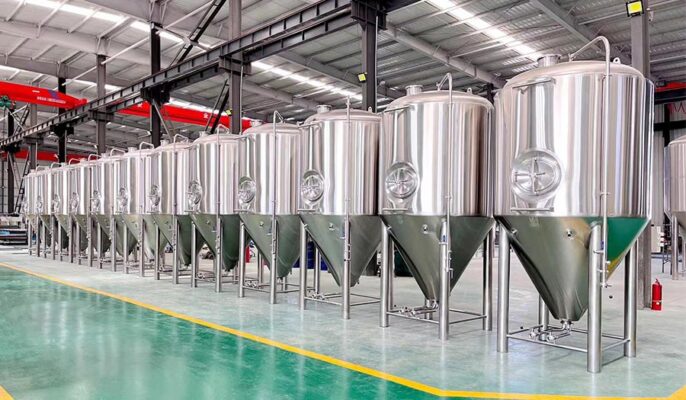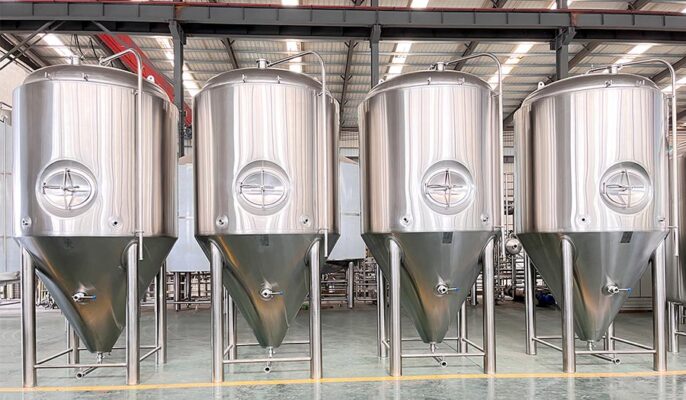Fermenters are available in a variety of sizes and formats to suit the needs of the brewer. Size is the main factor to consider when purchasing a fermenter. During the entire fermentation process, also to the wort, a thick layer of foam is formed, called Clausen foam. If your fermenter is too small, the foam will increase through the airlock, clogging the airlock and causing a blowout. The fermenter must be at least twenty percent larger than the amount of beer you intend to brew. Once you determine the size of the fermenter you need, you can decide on the most suitable style and material. Each type of fermenter has its advantages and disadvantages, but, your decision depends on budget and personal preference.
発酵槽の種類
There are three main types of fermentation tanks, let’s take a look at them.
オープントップ発酵タンク
オープントップ発酵槽は、蓋やシールのないシンプルな容器で、最も基本的なタイプの発酵槽です。キャップ(発酵中に表面に浮き上がるブドウの皮と種の層)に簡単にアクセスして手動で押すことができるため、ワインの発酵に使用されます。
密閉発酵タンク
密閉発酵槽には密封された蓋があり、外部汚染物質が発酵プロセスに侵入するのを防ぎます。これらは、腐敗や異臭の原因となる可能性のある空気への暴露から液体を保護するため、ビールの醸造に使用されます。
Variable capacity 発酵タンク
可変容量発酵槽にはフローティング蓋と調整可能な容量があり、さまざまな量の液体の発酵に適しています。柔軟性があり、発酵液との空気接触量を減らすのに役立つため、自家醸造家や小規模醸造家の間で人気があります。

What size primary fermenter is required?
In the early stages of fermentation, a thick layer of foam will form on top of the wort, called clausen. Clausen helps protect the fermenting wort from infection and is a good indicator of how things are going. As fermentation ends, the amount of Clausen decreases.
If you were to fill a fermentation vessel with wort, Clausen would have nowhere to go and would be forced through an airlock that might be clogged. The pressure in the fermenter then increases until the airlock is blown out.
To stop this from happening, you should choose a fermenter that is 20% larger than the volume of beer you want to brew. This leaves a space at the top of the fermenter, called headspace.
Most homebrew recipes are designed to produce five-gallon batches of beer and must a six-gallon or six-and-a-half-gallon fermenter.
What size fermenter is needed for secondary fermentation?
Once fermentation is complete, you can bottle or barrel the beer, or transfer it to a second container for aging. speaking, secondary fermenter is a misnomer because almost no fermentation occurs. More hops, spices and other ingredients can also be added at this stage.
Unlike primary fermenters, primary fermenters must more headspace for Clausen formation. The secondary fermenter should be as full as possible. This minimizes the amount of air exposure and reduces the chance of oxidation and unwanted off-flavors in the beer.
What size more fermenter is needed?
The beer can be bottled or kegged, or it can be transferred to a second container for aging after fermentation is complete. The second fermenter must be as complete as possible. This reduces the amount of air exposed and the chance of the beer oxidizing and developing undesirable off-flavors. For the 5-gallon kit, you will need a 5-gallon secondary fermenter.
Fermentation tank material selection
Plastic buckets and basins
Many homebrewers use food-grade plastic buckets as their fermentation tanks. Plastic kegs are cheap, lightweight, easy to store, and can be purchased with air locks and spigots for bottling finished beer. transfer wort from pot to fermenter. Fermentation barrels are available in a variety of sizes, from 5 liters (1 gallon) to 30 liters (8 gallons). Or you can buy a food grade container and add an airlock and tap it yourself.
The disadvantage is that the lid is not sealed and oxygen can enter.

Glass bottle
Glass bottles have long been the go-to choice for home brewing and winemaking. Glass jugs and vials come in a wider range of sizes, from half-gallon (three-liter) jars to 15-gallon (54-liter) vials. The glass is wear-resistant and will not scratch. It is also 100% oxygen impermeable and does not absorb taste or odor.
Unlike buckets, small and large bottles are heavy and difficult to store because they cannot be stacked. They also usually don’t have taps, which means you have to use a siphon or rack rod to transfer your beer.
ステンレス製発酵タンク
Stainless steel fermenters offer all the benefits of plastic fermenters but are scratch-proof, impermeable and very easy to clean. If you have the budget, Micet suppliers sell stainless steel fermentation tanks in various sizes. If you’ve ever visited a commercial brewery, you’ll notice that fermentation takes place in tall stainless steel vats that taper toward the bottom.
Conical fermenters allow breweries to remove dregs from the beer without pouring it into a second container. This means that primary and secondary fermentations can take place in the same barrel without putting the beer at risk of contamination. Conical fermenters also make it easy to harvest yeast, which can then be cleaned and reused.
How to choose the right fermenter for your needs
When selecting a fermentation tank, the following factors should be considered:
- The type of beverage or food you plan to ferment
- Your experience level and skills
- Available space in brewing or fermentation area
- Your budget
- Required fermenter capacity





私はあなたがここでできる以上に大好きでした。絵もいいし、文章もオシャレだけど、急ぎ足な感じなので、近いうちにまたあげたほうがいいと思います。あなたがこの散歩を守ってくれたら、私はおそらく何度でもそうするでしょう。